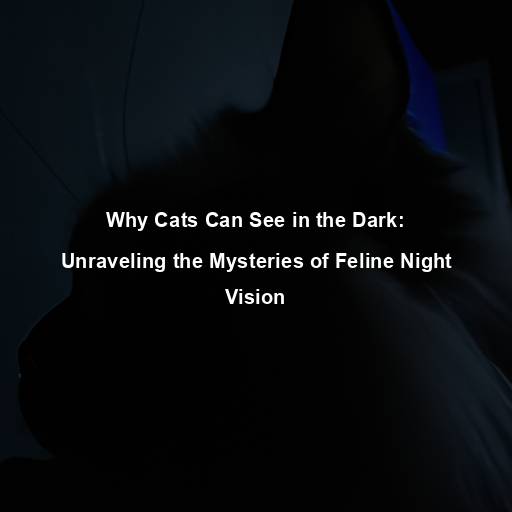Why Cats Can See in the Dark: Unraveling the Mysteries of Feline Night Vision
Last Updated on November 7, 2023 by Evan
Contents [hide]
- 1 Understanding the Phenomenon of Cats Seeing in the Dark
- 1.1 The Role of the Feline Eye Structure
- 1.2 The Magical World of Feline Night Vision
- 1.3 Evolutionary Reasons for Feline Night Vision
- 1.4 Debunking Common Misconceptions
- 1.5 The Fascinating World of Feline Night Vision Continues…
- 1.6 The Role of Photoreceptor Cells in Feline Night Vision
- 1.7 The Genetic Underpinnings: Genes and Night Vision
- 1.8 The Genetic Blueprint: The Cat’s DNA
- 1.9 The Role of Evolutionary Selection
- 2 Beyond Vision: The Multisensory Experience of Cats in the Dark
- 3 The Evolutionary Story: From Nocturnal Ancestors to Modern-Day Hunters
- 4 Beyond Cats: Exploring Night Vision in Other Nocturnal Animals
- 5 FAQs: Why Cats Can See in the Dark
Understanding the Phenomenon of Cats Seeing in the Dark
Cats have long been associated with their ability to navigate in darkness with ease. Their remarkable night vision has intrigued scientists and pet owners alike for centuries. But what is it that enables cats to see in the dark? In this article, we will delve into the fascinating world of feline night vision, exploring the anatomical and physiological adaptations that grant our feline friends this remarkable ability.
The Role of the Feline Eye Structure
When it comes to navigating the dark, cats seem to possess some sort of mystical superpower. Their uncanny ability to see clearly in low-light conditions can be attributed to their incredible feline eye structure. Packed with an array of specialized adaptations, their eyes are designed to excel in the darkness, leaving us mere humans in awe and wonder.
The Remarkable Power of the Cat’s Pupil
The shape and size of the cat’s pupil play a significant role in their ability to see in the dark. Unlike humans, whose pupils are round, cats have vertically elongated pupils that can expand and contract rapidly. This design allows them to adjust the amount of light entering their eyes, effectively reducing the intensity during brighter moments and dilating to capture more light in darker environments.
The Mirror-Like Tapetum Lucidum
Have you ever stopped to ponder the enigmatic wonders of a cat’s eye? There is so much more to it than meets the gaze! Nestled mysteriously behind the retina lies a magical layer called the tapetum lucidum. This captivating tissue serves as a shimmering mirror, defying our comprehension by reflecting and amplifying incoming light, thus empowering these feline creatures to excel in the realm of darkness.
High Density of Rod Cells
When it comes to deciphering the mysteries of sight, one cannot overlook the remarkable rod cells found in the retinas. These tiny yet powerful entities have the uncanny ability to detect light, turning bits and pieces of illumination into a vivid tapestry of visual information. And while we humans may have our fair share of these light-sensing champions, it is the feline kingdom that boasts an astonishing surplus of them. Yes, cats, those enigmatic creatures with eyes that seem to hold the secrets of the universe, possess an abundance of rod cells that puts our measly human count to shame.
The Magical World of Feline Night Vision
Unlocking the enigmatic realm of feline night vision extends far beyond mere surface knowledge. Delving deep into the intricate tapestry of anatomical adaptations, we uncover a captivating saga woven by the intricate interdependence of their mesmerizing ocular faculties, cerebral faculties, and elusive sensory mechanisms. Intriguingly, the cat’s nocturnal prowess unveils a mesmerizing symphony of complexity, shrouded in an enchanting veil of bewilderment.
Enhanced Sensitivity to Motion
Cats have an innate sensitivity to motion, making them exceptional predators. Their eyes are finely tuned to detect even the slightest movement, allowing them to track and capture prey efficiently. This heightened motion sensitivity is due to the presence of specialized cells called “motion detectors” in their visual cortex, which analyze visual stimuli and help them perceive movement with precision.
The Role of the Cat’s Whiskers
Have you ever wondered why cats seem to have a sixth sense when it comes to navigating in the dark? Well, it turns out that their whiskers play a crucial role in their remarkable night vision. These amazing vibrissae, as they are scientifically called, are not just for show – they are incredibly sensitive to the tiniest shifts in the air. This means that even with limited visibility, our feline friends can confidently whisk their way through narrow spaces and effortlessly judge the distance between objects in their environment.
Adaptations in the Cat’s Brain
The feline brain is finely tuned to process visual information in low-light conditions. The visual cortex of cats contains a higher density of neurons dedicated to processing visual stimuli compared to humans. This increased neural processing power allows cats to make sense of the limited visual cues available in the dark, providing them with a remarkably detailed perception of their surroundings.
Evolutionary Reasons for Feline Night Vision
Cats’ ability to see in the dark is truly remarkable, a mesmerizing spectacle that leaves us in awe. It is a product of countless years of evolution, a captivating journey that unravels the mysteries of nature. Immersing ourselves in the intricate web of reasons behind this extraordinary adaptation, we gain a profound sense of wonder and admiration.
The Evolutionary Advantage of Hunting in the Dark
Cats are natural hunters, and their ability to see in the dark has been a crucial factor in their survival and success as predators. Many of their preferred prey species, such as rodents and small mammals, are nocturnal or crepuscular, meaning they are most active during the night or twilight hours. By being able to see clearly in low-light conditions, cats have gained a significant advantage over their prey, ensuring their survival and providing a steady source of food.
The Genetic Inheritance of Night Vision
Throughout millennia, the mesmerizing ability of feline night vision has woven an enigmatic tapestry deeply connected to their very essence. The intricate dance of countless generations has relinquished a remarkable genetic heritage, bestowing upon these majestic creatures an extraordinary ocular architecture and sensory prowess. Such an indelible legacy has enabled cats to navigate with seemingly supernatural finesse amidst the labyrinthine jungles and within the bustling embrace of our very human habitats. Their enigmatic adaptability continues to astound us, a testament to the elegant enigma they embody.
Debunking Common Misconceptions
As we marvel at the mesmerizing night vision abilities of our feline companions, it’s time to unravel the intricate web of misconceptions that surround them. Contrary to popular belief, cats’ night vision is not without its complexities, leaving us puzzled and eager to gain a deeper understanding of their remarkable visual prowess. So, let’s delve into the enigmatic world of cat vision and shed light on the perplexing truths that lie beneath the surface. It’s time to demystify the secrets of their nocturnal kingdom and embrace the burst of knowledge that awaits us.
Cats Cannot See in Total Darkness
Cats possess an extraordinary knack for navigating dimly lit environments, capturing our intrigue and making us wonder about their nocturnal prowess. Yet, it’s crucial to remember that, contrary to popular belief, cats are not equipped with the power to perceive their surroundings in pitch-black darkness. Just like any other creature, these enigmatic beings rely on a glimmer of ambient light to make sense of their surroundings, highlighting their unique physiological adaptations that distinguish them from both humans and numerous other species roaming our planet.
Night Vision Varies Among Cat Breeds
While all cats share a common ancestry and possess adaptations for night vision, the degree of their visual acuity in the dark may vary among different breeds. Factors such as pupil size, the density of rod cells, and overall eye structure can differ slightly between breeds, potentially influencing their night vision capabilities. However, it is important to remember that all cats, regardless of breed, possess a superior ability to see in low-light conditions compared to humans.
The Fascinating World of Feline Night Vision Continues…
As the sun sets and darkness cloaks the world, cats effortlessly come to life, their keen eyes dancing with an otherworldly glow. The wonders of feline night vision have long puzzled both scientists and cat enthusiasts, leaving us yearning for answers to the enigmatic ways in which cats perceive the world when the lights go out. While we have made significant strides in unraveling the mysteries of their astoundingly sharp vision in low-light conditions, there is still a veiled realm of knowledge waiting to be discovered. Delving into the realm of feline night vision not only deepens our appreciation for these fascinating creatures, but also sheds light on the boundless diversity and adaptability of life on our awe-inspiring planet.
The Role of Photoreceptor Cells in Feline Night Vision
Delving into the enigmatic realm of feline vision unveils a captivating tapestry of ancient secrets. Behold the intricate tapestry of their extraordinary ocular machinery, wherein two distinct realms of photoreceptors reign supreme: the elegant convergence of cones and rods. Embark upon an odyssey through the ethereal bounds of feline visual prowess, forever shrouded in an enigmatic aura of mesmerizing perplexity.
Cones: Enabling Color Vision
Have you ever wondered why some animals can see better in the dark than others? Well, it all comes down to their amazing eyes and the clever way they are designed. Take cats, for example. These mysterious creatures have a unique visual system that allows them to navigate the night with ease.
Rods: The Powerhouse of Night Vision
When it comes to feline vision, rods take the spotlight, flourishing in dimly lit environments. Within these cells lies the magical rhodopsin, a pigment that grants cats the incredible ability to chase after the most elusive hints of light. With an abundance of rod cells nestled within their retinas, it’s no wonder that cats are the nocturnal kings of keen eyesight. The secret to their night vision supremacy lies within this perplexing density.
The Genetic Underpinnings: Genes and Night Vision
Cats, those enigmatic creatures, have long fascinated us with their ability to navigate the darkest of nights with ease. Their uncanny night vision, a gift from their genetic ancestry, is a testament to the wonders of evolution. Throughout millennia, the intricate dance of genes responsible for their unique eye structure and visual prowess has played out, resulting in their extraordinary ability to perceive the world in the dimmest of lights. It is a fascinating journey through time and biology that leaves us in awe of nature’s ingenious ways.
The Genetic Blueprint: The Cat’s DNA
Did you know that our feline friends possess an enigmatic secret in their DNA? Hidden within their genetic code lies the extraordinary prowess of their night vision. It is the intricate dance of specialized proteins, like opsin proteins, and the orchestration of rhodopsin production enzymes that contribute to their exceptional ability. However, any slight deviation or mutation in these genes can cast a mysterious shadow over their sight, leaving them with impaired vision in the darkness.
The Role of Evolutionary Selection
Natural selection has played a vital role in shaping the genetic makeup of cats over millions of years. Individuals with advantageous adaptations for night vision were more likely to survive and pass on their genes to subsequent generations. This continuous process of selection has ultimately led to the remarkable night vision capabilities we observe in cats today.
Beyond Vision: The Multisensory Experience of Cats in the Dark
While feline night vision is undoubtedly impressive, it is not the only sensory mechanism that allows cats to navigate in low-light conditions. Cats possess a range of other sensory adaptations that work in harmony to create a comprehensive understanding of their surroundings.
Whiskers: The Silent Guides
Delicate and enigmatic, cats possess an extraordinary feature that enhances their nocturnal prowess – the illustrious whiskers. These mystical tendrils, known as vibrissae, possess an innate ability to guide feline explorers through the cloak of darkness. Intricately entwined with nerve endings, these whiskers unravel the mysteries of their surroundings by delicately brushing against hidden objects, granting cats a tactile map of their realm. With this extraordinary and cryptic sense, felines effortlessly navigate their way through the dimly lit abyss, relying on their whispering vibrissae to unveil the secrets of their enigmatic environment.
Enhanced Hearing: The Sound of the Night
Cats have highly sensitive ears that can detect a wide range of frequencies, including those emitted by small prey animals scurrying in the dark. Their ability to localize sounds with pinpoint accuracy allows them to track movements and pounce on unsuspecting prey. This acute sense of hearing complements their night vision, creating a formidable combination for nocturnal hunting.
Cats, those enigmatic creatures of the night, possess an uncanny ability to navigate their surroundings that goes beyond just their remarkable vision and hearing. Their olfactory prowess, finely honed and mysterious, grants them the power to unravel a vast tapestry of scents in the dark. It is through this intricate sense of smell that felines are able to trace invisible trails, recognize familiar landmarks, and uncover hidden perils that lurk in the shadows of their territory. Behold the perplexing prowess of cats, as they unravel the secrets of their aromatic domain.
The Evolutionary Story: From Nocturnal Ancestors to Modern-Day Hunters
The fascinating realm of feline vision unveils a profound tale of evolution. Within the ebb and flow of time, cats have embarked on a captivating journey, adapting to the secrets of the night. Their exquisite night vision, an exquisite masterpiece, bears the intricate imprints of the diverse habitats they have graced throughout the ages.
The Nocturnal Ancestors
Cats’ ancestors were primarily nocturnal creatures, adapting to life under the cover of darkness. As they evolved and diversified, their visual system underwent significant changes to optimize their hunting abilities in dimly lit environments. The selective pressures of the night led to the emergence of feline species with enhanced night vision adaptations.
Modern-Day Hunters
Today, domestic cats retain many of the adaptations that allowed their ancestors to thrive in the dark. While house cats may not rely on hunting for survival, their inherited night vision adaptations continue to shape their behavior and interactions with their environment. Whether it’s playfully pouncing on a toy or stealthily stalking a perceived prey, the vestiges of their evolutionary past are still evident in their behavior.
Beyond Cats: Exploring Night Vision in Other Nocturnal Animals
While cats are known for their exceptional night vision, they are not the only creatures that navigate the darkness with ease. Many other nocturnal animals possess their own adaptations for seeing in dim light.
Owls: Silent Hunters of the Night
When it comes to navigating the dark, owls truly take the spotlight. Their mesmerizing eyes, with their impressive size and a gaze that seems to pierce through the night, hold the secret to their exceptional low-light vision. Like feline counterparts, these nocturnal creatures possess a concentrated army of rod cells, enabling them to seize even the faintest glimmers of light. Not only that, the architectural marvel of their eyes amplifies the light-capturing capabilities, ensnaring any opportunity to excel at nocturnal hunting expeditions.
Tarsiers: Masters of Moonlight
Tarsiers, small primates found in Southeast Asia, are known for their enormous eyes relative to their body size. These eyes have a high concentration of rod cells, making them well-suited for nocturnal living. Tarsiers’ unique adaptations allow them to capture even the dimmest of moonlight, ensuring their survival in the dark forests they call home.
FAQs: Why Cats Can See in the Dark
Can cats really see in the dark?
It’s truly fascinating how our feline friends possess such remarkable night vision capabilities. It’s like they have their own built-in spotlight, enabling them to see fairly well even with minimal light. While they may not conquer the absolute darkness, their eyes have expertly adapted to maximize any glimmer of light that comes their way, empowering them to effortlessly navigate and catch their prey in the shadows. Their ability to thrive in dimly lit surroundings is nothing short of awe-inspiring!
How do cats see in the dark?
In the realm of feline mystique, lies a captivating secret of their gaze that beckons the curious mind. Behold, the tapetum lucidum, a wondrous ocular marvel that gifts our furry companions with a nocturnal prowess like no other. This enigmatic structure, nestled delicately behind their retinas, holds the power to transform darkness into illumi
What makes a cat’s eyes different from ours?
A significant difference between cats’ eyes and human eyes is the presence of a higher concentration of rod cells in cats. Rod cells are responsible for detecting light and are more sensitive to low light levels than the cone cells responsible for color vision. This abundance of rod cells, combined with the tapetum lucidum, allows cats to see better in darkness compared to humans.
Can all cats see equally well in the dark?
While most cats have excellent night vision, the extent of their ability to see in the dark can vary based on certain factors. Factors such as breed, age, and overall health can influence a cat’s night vision. Generally, larger cat breeds such as Maine Coons tend to have better night vision than smaller breeds. Additionally, younger cats have better low-light vision compared to older cats, and cats with certain eye conditions or health issues may experience some degree of vision impairment even in dim light.
Do cats rely only on their vision in the dark?
When the sun goes down, cats unleash their hidden powers of perception. While their mesmerizing eyes are the stars of the show, their other senses are no mere supporting acts. With ears finely tuned to every whisper in the night, they track the faintest rustle of prey or approaching danger. And their noses, like master detectives, sniff out the scent trails that lead to sustenance or bring comfort. In the cloak of darkness, these feline marvels orchestrate a symphony of senses, allowing them to conquer the night with grace and survival instincts that bewilder us all.
Can humans improve their night vision to be as good as cats?
In the intricate tapestry of the visual realm, humans may find themselves at a dainty disadvantage when it comes to the realm of nocturnal vision. However, fear not, for in the sorcery of modern science and ingenious contraptions, there lie possibilities waiting to be unraveled. These enigmatic contraptions, known as night vision goggles, have the power to unlock hidden dimensions of darkness by amplifying the feeble rays of existing light. But do not be deceived, dear reader, for such grandeur comes at a price – even with these marvels of innovation, the elusive grace of feline night vision remains an enigma beyond our grasp.







